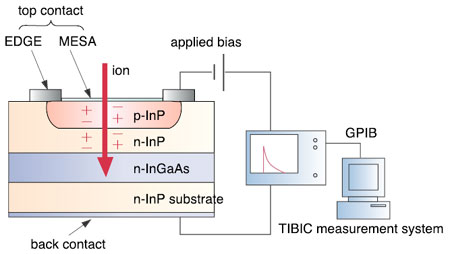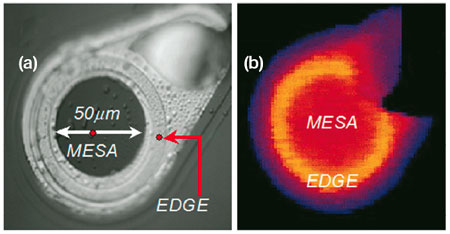Optical communication devices such as photodetectors in high-radiation environments such as outer space suffer from several long-term and short-term problems due to the high radiation levels. One such problem occurs when high-energy protons or neutrons generate high-energy heavy ions by recoil or by nuclear reactions. If these ions pass close to, or through the sensitive volume of a photodetector, the electron-hole pairs generated by the ion's energy loss can result in spurious Single Event Transients (SET) that generate Single Event Upset (SEU)-type communication errors. Such events degrade the Bit Error Rate (BER) of the photoreceiver module. In this particular work, the heavy ion microbeam at JAERI has been used to examine the spatial characteristics of the Avalanche Photodiode (APD) whose structure is indicated in Fig. 6-1. In an APD, photons whose energy is above the bandgap are absorbed in the n-InGaAs region, and their signal is multiplied in the top InP multiplication region by impact ionization. This multiplication effect is the so-called device gain. The gain of the APD is an important parameter, as is its uniformity across the active region of the device. Structural variation across the APD can cause variations in gain that may lead to unnecessarily large SET signals. Locating regions which exhibit large SET amplitudes is important for determining device designs that meet stringent radiation assurance guidelines.
For this work, an 18 MeV O ion beam has been scanned across the APD, the optical image of which is displayed in Fig. 6-2 (a). SET signals were measured using a high-bandwidth measurement system called Transient Ion Beam-Induced Current (TIBIC). Shown in Fig. 6-2 (b) is the resultant image formed from the SET peak current across the device. These results indicate that higher electric fields near the edge region (EDGE) are responsible for premature impact ionization, leading to larger gains than expected. Higher gains at the EDGE are problematic, increasing overall device BER, i.e., the probability of errors. Further ion beam tests have been performed to examine device behavior as a function of various parameters such as bias and temperature. Models explaining the observed behavior have been postulated, and the existence of an anomalous gain has been reported. These results, in conjunction with electrical tests, can be used to further enhance APD designs for space applications.
|

